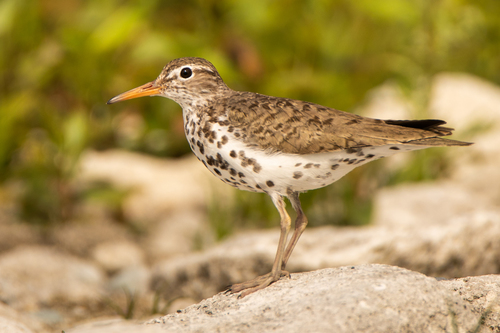
Spotted Sandpiper
The Spotted Sandpiper (*Actitis macularius*) is a small, lively shorebird widespread across North and South America. It is easily recognized by its distinctive breeding plumage, featuring bold dark spots on its breast and belly, and its characteristic teetering or bobbing motion. This species plays a vital role in controlling insect populations near freshwater habitats. Unlike many shorebirds, the Spotted Sandpiper exhibits polyandrous mating behavior, where females may mate with multiple males, who then take on the primary role of incubating eggs and raising young. This unusual behavior makes it a fascinating subject for behavioral ecology studies. It holds no specific, widely recognized cultural significance, but its presence is often seen as an indicator of healthy wetland ecosystems.
Least Concern
Conservation Status
Distribution
Breeds across most of North America, from Alaska and Canada south to the southern United States. Winters in the southern United States, Central America, and South America, as far south as Argentina and Chile. Found across a wide altitudinal range, from sea level to over 4,000 meters.
Lifespan
Average lifespan in the wild is approximately 8-10 years, although individuals over 12 years old have been recorded.
Spotted Sandpiper's Habitat
Habitat Types
Riverbanks, Lake shores, Ponds, Streams, Coastal areas, Wet meadows, Marshes
Climate Zones
Temperate, Subtropical, Tropical
Adaptations
Their preference for freshwater habitats with vegetated edges provides camouflage and ample insect prey. Their slightly webbed feet aid in navigating muddy or sandy substrates. They are highly adaptable to various elevations, provided there is a water source and insect prey.
Variations
No recognized subspecies, although some slight regional variations in size and plumage intensity may occur.
Appearance
Breeding Plumage
Breeding plumage features bold dark spots on a white breast and belly. Non-breeding plumage is duller, with a plain brownish-gray back and white underparts lacking spots.
Seasonal Feather Changes
Spots are most prominent during the breeding season (spring and summer). They fade or disappear entirely during the winter.
Sex Based Plumage Differences
Females tend to have slightly bolder spotting than males, especially during breeding season.
Notable Features
Constant teetering or bobbing motion, Orange bill with a dark tip (breeding season), Yellowish legs, White eye-ring
Diet and Feeding
Primary Foods
Insects, Crustaceans, Small fish, Spiders, Worms, Mollusks
Foraging Behavior
Actively forages along shorelines and in shallow water, picking prey from the surface or probing in mud. Often seen teetering or bobbing while foraging. Will occasionally catch flying insects.
Specializations
Their visual acuity and quick reflexes allow them to capture fast-moving insects. Their bill is well-suited for probing and picking.
Seasonal Diet Variations
Diet shifts slightly depending on prey availability. During breeding season, insects are the primary food source. In winter, they may consume more crustaceans and small fish.
Behavior
Social Structure
Generally solitary or found in pairs during breeding season. May form small flocks during migration and winter.
Communication
High-pitched 'peet-weet' calls, Rapid series of 'weet' notes during courtship, Wing-fluttering displays, Teetering or bobbing
Migration
Migrates at night, often in small groups. Follows coastlines and river valleys. Some populations are short-distance migrants, while others travel long distances between North and South America.
Territorial or Group Behaviors
Males defend nesting territories. Females may defend territories against other females, especially when competing for mates. Outside of breeding season, they are generally less territorial.
Conservation
Threats
Habitat loss and degradation (wetlands, shorelines), Pesticide contamination, Pollution of waterways, Climate change (altered precipitation patterns, sea-level rise)
Protection Programs
Migratory Bird Treaty Act (US), Species at Risk Act (Canada), Wetland conservation initiatives
Local National Laws
Protected under various state and provincial wildlife regulations.
Population Trend
Generally stable, although some regional declines have been noted.
Population Estimates
Global population estimated to be around 400,000 individuals (Partners in Flight).
Interesting Facts
Spotted Sandpipers exhibit reversed sexual roles.
Females are larger and more aggressive, competing for multiple male partners, while males primarily incubate eggs and raise young.
They are known for their constant teetering motion.
This characteristic bobbing of the tail and body is thought to help them spot prey or communicate with other sandpipers.
Chicks are precocial and can swim shortly after hatching.
This adaptation allows them to escape predators and forage independently at a young age.
They have one of the largest breeding ranges of any North American shorebird.
Adaptable to many elevations.
Faqs about Spotted Sandpiper
Why do Spotted Sandpipers bob their tails?
The exact reason is not fully understood, but it may help them spot prey, maintain balance, or communicate with other sandpipers.
Where can I see a Spotted Sandpiper?
Look for them near freshwater habitats like rivers, lakes, and ponds, especially during the breeding season (spring and summer) in North America. They can also be found along coastlines during migration and winter.
Are Spotted Sandpipers endangered?
No, they are currently classified as 'Least Concern' by the IUCN, but habitat loss and pollution remain threats.
What do Spotted Sandpipers eat?
They primarily eat insects, but also consume crustaceans, small fish, spiders, worms, and mollusks.
Do both male and female Spotted Sandpipers incubate the eggs?
Primarily the male incubates the eggs, while the female may mate with other males and lay additional clutches.
Copyright @ Nature Style Limited. All Rights Reserved.

 English
English